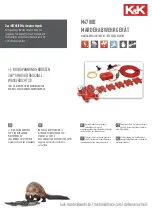
3
valve using wrench flats. DO NOT OVER-
TIGHTEN.
Flat-faced flanged valves should be mated with
flat-faced flanges and full-face gaskets. If ring
gaskets are used the bolt material shall be
ASTM A307 Grade B (or equivalent). Higher
strength bolting should only be used with full-
face gaskets.
Lower heavy valves over the mating flange
using slings or chains around the valve body.
Lubricate the bolts or studs and insert around
flange. Lightly tighten bolts until gaps are
eliminated. Torque bolts in an alternating
pattern in graduated steps. If leakage occurs
wait 24 hours and re-torque the bolts but do not
compress the gasket more than 50% or exceed
bolt maximum torque rating.
VALVE CONSTRUCTION
The standard Figure 942 Durovent
™ Sewage
Combination Air Valve has a cast 316 stainless
steel body, 316 stainless steel float and linkage
mechanism and a Buna-N rubber seat. It has a
working pressure range of 10 to 150 PSI.
Optional materials can be provided for higher
working pressures. Refer to the List of Materials
submitted for the order if non-standard materials
were provided.
Refer to Page 5 for details of construction and
parts location.
The valve has an inlet connection at the bottom
where the valve attaches to the system and an
outlet connection at the top through which air
exits and enters the valve.
WARNING
Removing the valve from the line or
disassembling the valve while there is pressure
in the valve body may result in injury or damage
to the valve
PREVENTIVE MAINTENANCE
Figure 942 Durovent
™ Sewage Combination Air
Valves require no scheduled lubrication or
adjustment.
A periodic visual inspection should be performed
to ensure the outlet piping is not obstructed and
to verify there is no fluid leakage.
Depending on the nature of the fluid, sewage air
valves may become clogged with sediment or
grease and require periodic cleaning. To
facilitate such cleaning GA Industries air valves
with an “F” at the end of the Figure Number
(e.g., 942F)
were supplied with “backflushing
attachm
ents.” Refer to the backflushing
instructions on Page 4 of this manual for
additional information.
TESTING
Valve operation can be easily tested. Close the
inlet isolation valve and remove or loosen the
pipe plug nearest the inlet to drain the water
from the valve. The float should drop as the
water leaves the valve. NOTE: A manual valve
can be installed in place of the pipe plug to
facilitate testing (valves are included with
backflushing attachments).
Replace or tighten the pipe plug and slowly open
the inlet isolating valve. After expelling air, the
valve should close and seal tightly.
TROUBLESHOOTING
•
Valve Does Not Close / Fluid Leakage
Verify there is at least 10 PSI at the valve
inlet for tight sealing
Verify debris has not collected on the seat
preventing tight closure
Verify rubber small and/or large orifice
seating surfaces are not damaged
Verify float has buoyancy
Verify linkage mechanism operates freely
without binding or sticking
•
Valve Does Not Open
Verify debris in the valve is not
preventing the float from freely falling
when fluid is drained from valve
Verify linkage mechanism operates freely
without binding or sticking
Verify pressure at valve inlet does not
exceed 150 PSI
DISASSEMBLY
While small valves may be more easily serviced
by removing it from the line, all valves can be
serviced while the body remains connected to
the pipeline. A skilled technician with proper
tools should perform all work. No special tools
are required.
2























